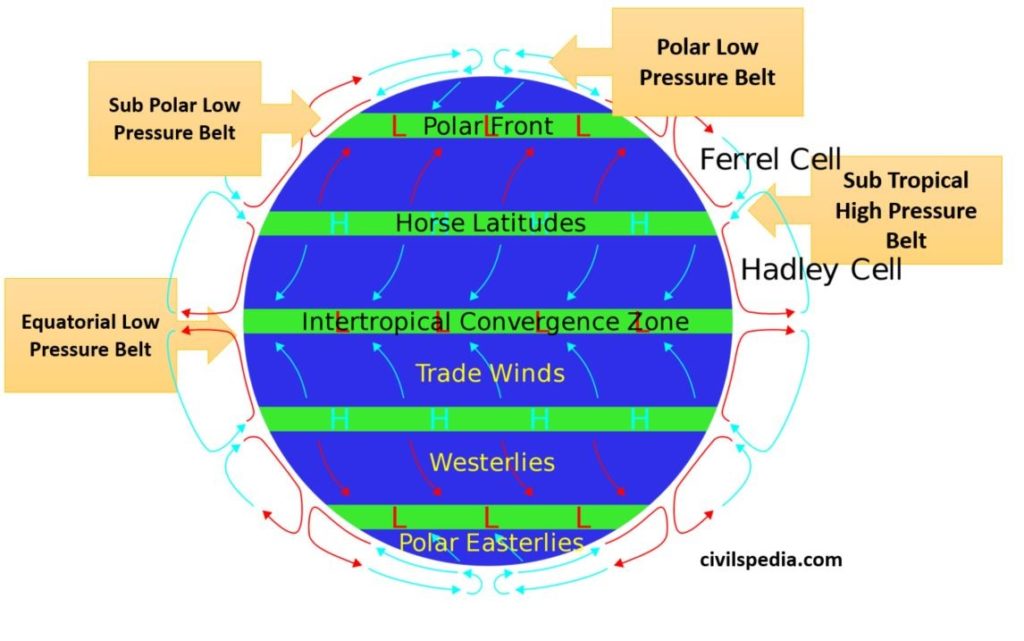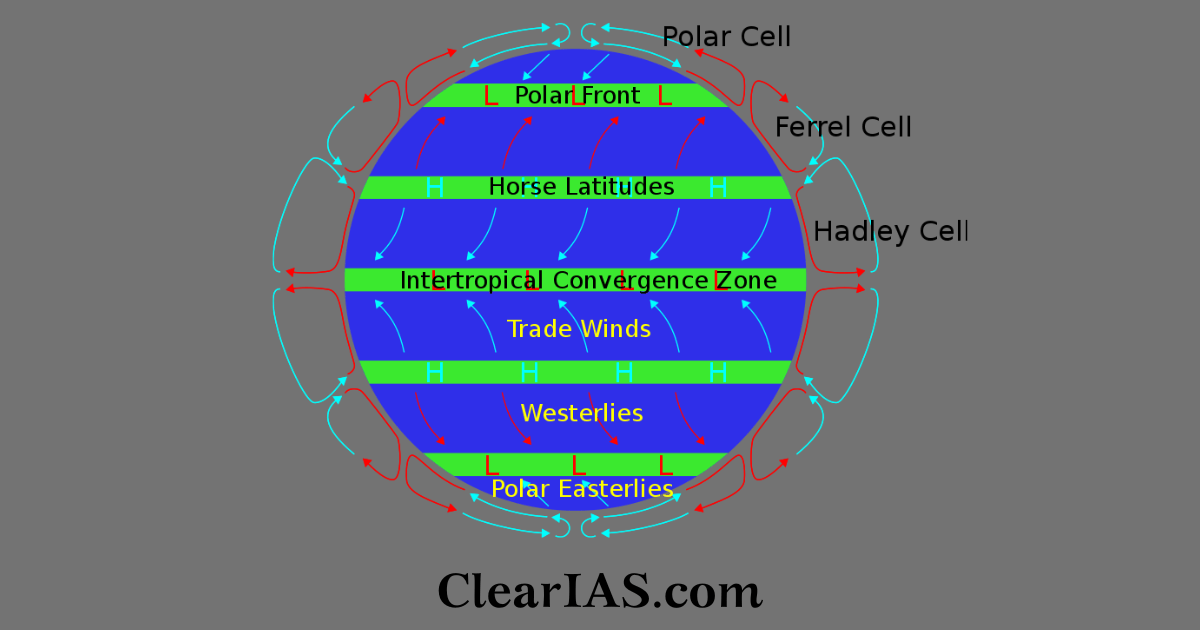
How Pressure Belts Change the Weather DISCOVERSIO YouTube
Let's turn now to actual global surface wind and pressure patterns, shown in Figure 5.17. The subtropical high-pressure belts, created by the Hadley cell circulation, are important features. In the northern hemisphere, they include two large high-pressure cells that flank North America—the Hawaiian and Azores highs.
Pressure Belts of the World Geography for Competitive Exams APPSC Material, Group 1 Group 2
Next Pressure Belts and Planetary Winds Pressure varies from one place to the other place and also decreases with altitude resulting in world pressure belts and planetary winds. Atmospheric pressure is nothing but the force exerted by the atmospheric column on a unit area of earth's surface.

PRESSURE BELTS AND THEIR SEASONAL VARIATIONS Environment
World pressure belts e diagram in Figure 1.8 shows, in static (not moving) two-dimensional form, the Earth s pressure belts. In reality, this is a dynamic three-dimensional system. Figure 1.8 A simpli ed representation of the Earth s pressure belts 60° 30° 0° 30° 60° subpolar low subpolar low subtropical high subtropical high

Pressure and Pressure Belts
Shifting of Pressure Belts - Geography Video | Iken EduGeography video lecture explaining about Pressure belts in atmosphere. Learn about the shifting of pr.

Pressure and Pressure Belts
The diagrams above and below portray just the Hadley cell circulation, that is driven by heating in the equatorial region. On the surface, wind moves away from high pressure (High) and toward low pressure (Low).. and Divergence occurs under the descending air that forms high-pressure belts. The final figure (Figure 26) shows all six cells.

Pressure and Pressure Belts
60oN and 60oS, the low-pressure belts are termed as the sub polar lows. Near the poles the pressure is high and it is known as the polar high. These pressure belts are not permanent Figure 10.2 : Distribution of pressure (in millibars) — January Figure 10.1 : Isobars, pressure and wind systems in Northern Hemisphere velocity.

Introduction to Pressure Belts, Isobars and Associated Weather (Horizontal & Vertical Wind
Pressure Belts of the Earth refer to the regions that are dominated either by high-pressure cells or low-pressure cells. The high and low-pressure belts are arranged alternatively on the Earth's surface. The pressure belts are formed on the earth's surface because Warm air is light, and the air at the Equator rises, creating low pressure.

PPT Global Pressure Belts PowerPoint Presentation, free download ID214594
The air from sub-polar low pressure belts after saturation becomes dry. This dry air becomes cold while moving towards poles through upper troposphere. The cold air (heavy) on reaching poles subsides creating a high pressure belt at the surface of earth. Climate. The lowest temperatures are found over the poles. Pressure belts in July

a neat diagram showing pressure belts label the diagram Brainly.in
Due to the presence of land masses, the large-scale pressure belts are broken up in several areas of low and high pressure (see Fig. 4.6). Both the topography of a certain area (mountains affect the pressure distribution) and the differential warming of the oceans and the land play a role. Resulting typical wind pat- terns for the months of.

Pressure BeltsEverything You Need To Know ClearIAS
Pressure belts are those areas on the surface of the earth where the same pressure is distributed differently based on latitude. These are developed due to High or Low-Pressure cells. These high- or low-pressure cells produce high- or low-pressure belts.

Pressure Belts of the Earth Notes EduRev
Earth's Atmospheric Circulation System. The global atmospheric circulation system influences the movement of air masses in general wind belts that move air in rotating masses within zones around the planet. These wind belts seem relatively stable when viewed in a long-term view (decades). However, fluctuations may occur on seasonal or annual.

Pressure Belts 6th Std Geography English Medium Maharashtra Board Home Revise YouTube
The orientation or direction of a pressure gradient is always described as being from higher toward lower pressure. The speed of the wind is controlled by the strength of the pressure gradient, the stronger the pressure gradient the higher the wind speed. The strength of the pressure gradient can be discerned from the spacing of isobars on a.

Surface pressure distribution with all four pressure belts Download Scientific Diagram
The horizontal distribution of air pressure across the latitudes is characterized by high or low pressure belts. This is however, a theoretical model because pressure belts are not always found as such on the earth. These pressure belts are: (i) The Equatorial Low Pressure Belt; (ii) The Sub tropic High Pressure Belts;
Raja Babu Pressure Belts and Winds
Nov 10, 2023 Pressure belts are the areas of the Earth that are dominated by either high or low-pressure cells. These pressure belts are distributed all over the Earth in seven places. There are seven pressure bands on the earth's surface. These are the Equatorial Low, the two Subtropical highs, the two Subpolar lows, and the two Polar highs.

Pressure Belts INSIGHTSIAS
Key Concepts In this lesson we will focus on summarising what you need to know about: The mechanics present to create global wind and pressure belts as a response to the unequal heating of the atmosphere The relationships between air temperature, air pressure and wind

Pressure belts of the world UPSC Atmospheric circulation Climatology Physical Geography
Pressure Belts of Earth On the earth's surface, there are seven pressure belts. They are the Equatorial Low, the two Subtropical highs, the two Subpolar lows, and the two Polar highs. Except for the Equatorial low, the others form matching pairs in the Northern and Southern Hemispheres.